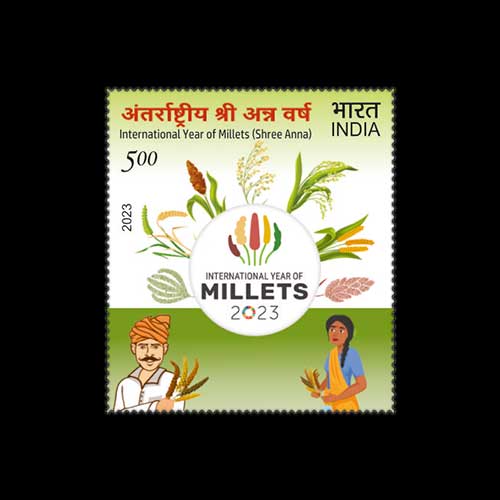Fascinating Archaeological Facts on Postage Stamps - 89
2025-08-21 Thu
The term “millet” is derived from the Latin word “milum,” which translates to grain. millets represent a group of small-grained cereal crops that are not only highly nutritious but also well-suited for cultivation in marginal and low-fertility soils. These crops are sometimes referred to as famine crops due to their reliability in yielding produce during times of food scarcity. India stands as the world’s largest producer of millets.Many millet varieties are indigenous to India and are often categorized as nutri-cereals, as they provide a substantial proportion of the nutrients essential for optimal human Healthy Life. In India, various types of millets are cultivated, including sorghum (jowar), pearl millet (bajra), finger millet (ragi), foxtail millet (kangni), little millet (kutki), kodo millet, etc.
According to the publication "Story of Millets" (2018) released by the Karnataka State Department of agriculture in collaboration with ICAR-Indian Institute of Millets research, millets were among the first crops to be domesticated by humans in Asia and Africa. They subsequently spread worldwide, serving as vital food sources for emerging civilizations. Significant Neolithic sites in India, such as Burzahom in Kashmir and Chirand in Bihar, have yielded millet grains, highlighting their historical importance as a fundamental food source. Research conducted by Pokharia et al. (2013) supports the view that millets played a critical role in shaping early Agricultural systems and significantly impacted the subsistence Economy of the Harappan civilization. Evidence of ragi has been discovered in locations such as Rojdi and Oriyo Timbo, while the cultivation of kangni, jowar, and bajra can be traced to several sites, including Rojdi, Kanmer, Oriyo Timbo, and Babar Kot, where kutki was also grown.
Additionally, Ankita and Seth (2025) note that archaeological findings suggest Kashmir functioned as a millet exchange hub in South and Central Asia during 3000–2000 BCE. Further research from the #IRON Age and Early Historic periods in regions such as Gujarat, Maharashtra, and the Deccan Plateau confirms the continuous cultivation of millets, demonstrating their adaptability to diverse climatic conditions. During the Deccan Chalcolithic Era, farmers in Jorwe engaged in kharif and rabi crop rotation, cultivating jowar and ragi.
Millets are also referenced in historical texts, including the Vedas, Puranas, and Samhitas, underscoring their cultural significance and nutritional value. Veerabadhran et al. in 'A Review of the #History and Practices of Millets (2023)' state that Kautilya’s Arthashastra acknowledged millets as one of the primary crops cultivated during the Mauryan #Empire. Furthermore, millets occupied a prominent position in Ayurveda, where their health benefits and therapeutic properties.
In recognition of their importance, the Food and Agriculture Organization (FAO) and the #United Nations designated the year of 2023 as the International Year of Millets (Shree Anna), to increase awareness of their health and nutritional benefits. To commemorate this initiative, India #post issued a commemorative stamp on 18 March 2023, for a face value of Rs. 5.
Latest News
-
Antiochos I Soter Silver Tetradrachm, weighing 16.87 grams, sold for INR 22,000.
2025-10-07 TueAntiochos I, the Greek king of the Seleucid Empire, was of mixed heritage, being half-Iranian and ha...
-
Ghiyath Shah as Heir Apparent
2025-09-25 ThuGhiyath Shah was the ruler of the Malwa Sultanate, reigning from 1456 to 1500. From 1456 to 1469, he...
-
Malwa Sultan Mahmud Shah Silver Coins
2025-09-11 ThuMalwa Sultan Mahmud Shah minted silver coins in round and square flans. <br><br> For round coins,...
-
Malwa Sultan Mahmud Shah Billon coin
2025-08-26 TueMalwa Sultan Mahmud Shah's billon coins followed three weight standards: 100 rati, 96 rati, and 80 r...
-
Fascinating Archaeological Facts on Postage Stamps - 91
2025-08-23 SatRhinoceros is one of the oldest land mammal species existing in India. There are five species of rhi...

